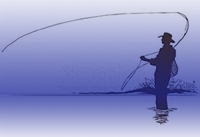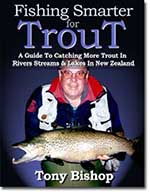


Sure, despite the fact that I was self-taught, I can get my fly out somewhere near where I want it most times, but too often when I really need to get it to where it needs to land I duff it up and watch the fish I was aiming to catch dart off to where-ever fish go when spooked.
I can most times get enough distance, but when the situation calls for an extra 3 or 4 metres I can almost guarantee the line wraps around my head, or collapses in a series of rings in front of me.
(Article continues below advertisement)
Then I got a bit of inspiration from Tiger Woods when I read that this truly gifted golfer spent much of a year re-building his swing. Good enough for Tiger I thought, good enough for me - so I grabbed a mate who is a very good caster, and club instructor, and we settled in to some rebuilding of my casting stroke.
My friend hit on my problem almost immediately when I fired off a demo cast. "Too fast, too slow", he observed.
What was he on about?
One of the key elements to getting a line going where and how far you want it too, is the "start slow, end fast, stop dead" saying. This saying describes the sequence of the cast.
With the line straight on the water, and the rod tip lightly touching the water, slowly lift the rod tip while pulling back with your rod hand. This will get the line moving and begin to lift it off the water. The pull of the water will load (bend) the rod.
Once the line has lifted from the water, accelerate the rod hand rapidly until it is alongside your face, then accelerate the line further with the briefest and smallest flick of the wrist, and immediately stop the rod hand dead! If you are using the thumb on top of the rod grip, (and I really recommend you do) your thumb, when you stop, must be pointing almost straight up. (You can allow your rod hand and arm to 'drift' back a little after the stop.)
(Article continues below advertisement)
As the line unrolls up and behind you the rod will momentarily unload (straighten) and then reload (bend backwards) as the line moves backward pulling the rod tip with it. It is this load that we need to take advantage of during the forward cast.
The weight and built up speed of the line going backward will do what the water did at the start of the back cast - load the rod up ready for the forward cast.
Wait for, or watch for, the line to start to slow and very nearly straighten behind you.
I think the often quoted advice to wait for the 'thud' as the line stops moving is bad advice to follow when learning to cast. If the line stops moving backward even for a millisecond the rod will unload and you will have a devil of a job making a forward cast. Do not worry about knowing if you are starting the forward cast too soon - a whiplash 'crack' of the line will let you know.
With the line now virtually straight out behind you, start the forward cast by starting slow to keep the rod loaded, and as the rod hand passes your ear (just visible in you peripheral vision) accelerate the rod hand rapidly, only about six inches or less, and finish with the briefest and smallest flick of the wrist, and stop dead!
If you have followed me this far you will note the with the exception of the starting on the water the back-cast is exactly the same as the forward cast.
A key thing to remember when learning to cast is all that is required is a few, simple, smooth, and well-timed actions.
A very common problem is trying to force the rod through the air; brute strength will not cast further, in fact, most often, just the opposite.
(Article continues below advertisement)
So here is the practice bit my friend set up for me. If you are near water, great, if not find a park or such. Use a line with a 4 or 5 metre (12 to 15 feet) leader and a piece of wool as a 'fly'.
Lay out 10m (30 feet) of line on the ground or water, and start by seeing how slowly you can move the rod hand and how far, to get it airborne. The aim here is to move the rod hand as slowly as possible. Once you have found that speed then see how short a distance you can accelerate your rod hand and micro-snap your wrist, stopping the rod dead to throw the line up and behind you.
Once you have got the back cast going, add in the forward cast using exactly the same principles.
One of the key advantages to moving the rod as slowly as possible before the power acceleration is that you have time to make mid-air corrections to the direction of the line - it helps with precision casting immeasurably.
If you are having problems, I can almost guarantee that you are trying to use too much 'power' or 'strength'.
Casting a fly-rod is about timing, and almost nothing about strength - so try using the least amount of strength you can to get the line moving. And when you have gone as low as you think you can, try to use less strength. This a good technique for any angler to try if things get messy - even experienced anglers.
Once the techniques described above are mastered the tasks of learning the 'haul', shooting line, long distance casting, and other casting techniques are easy.
And just a final little note, don't get too hung up on casting distance, most of the time, casting accuracy for long or short casts is the key to catching more fish.
But, and there always is one, sooner or later you do need to work on longer casts. Longer cast techniques are really useful if there is there is wind around, even when fishing water you normally have no difficulty covering the water with shorter casts. If you are looking to getting into saltwater fly-fishing longer casting ability is essential.

Article written by Tony Bishop (Bish)


My first trout fishing book Fishing Smarter for Trout is
now up on this site and free to read. Includes regular updates and new stuff.
How to Play and Land a Trout Correctly
It is one of the most important aspects of fly-fishing, yet it is one of the most often ignored in books, magazines, videos and the like - sadly, my books included.
You can read and view plenty about flies, fly tying, knots, casting, presentation, finding fish, tackle selection, et al, but what about playing and landing the fish once you have inwardly digested all that stuff and actually find yourself attached to one of these fabled fishes?
Fly-Rod 'Actions' -
What Do They Mean?
I guess one of the more confusing elements of fly-fishing is the hotchpotch of terms used to describe the “actions” of fly-rods.
Hopefully I can dispel some of this confusion and help making a decision on what fly-rod to buy easier.
